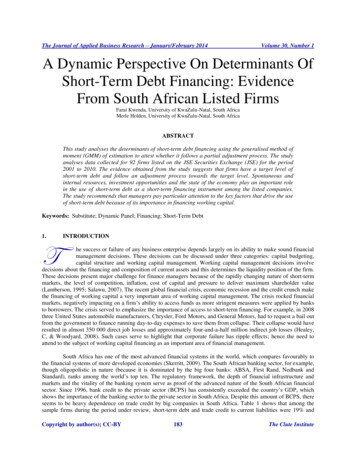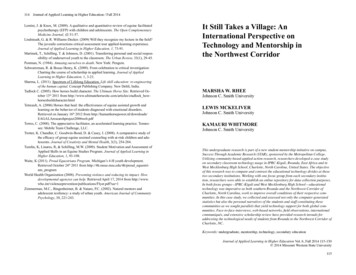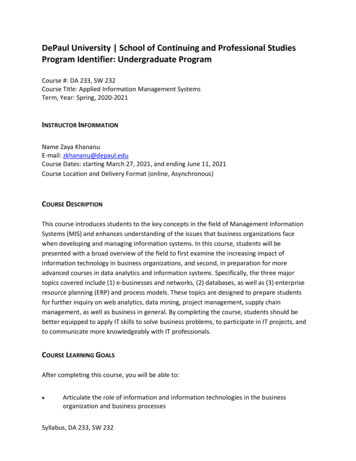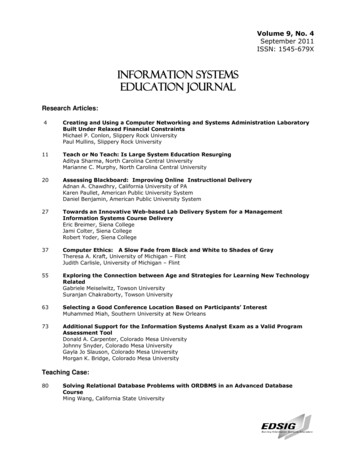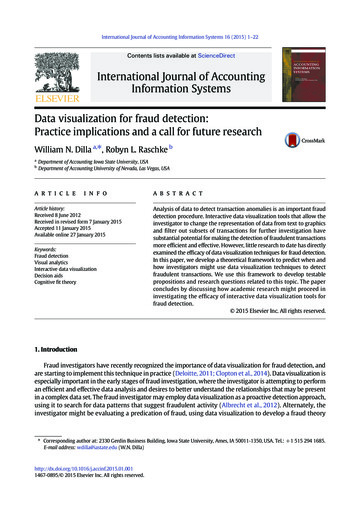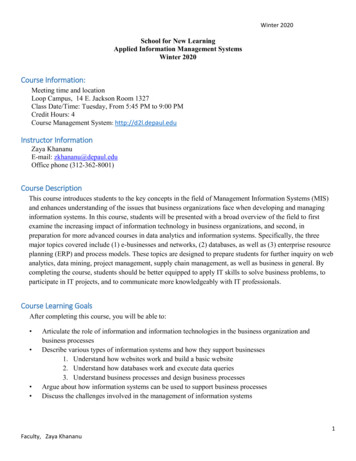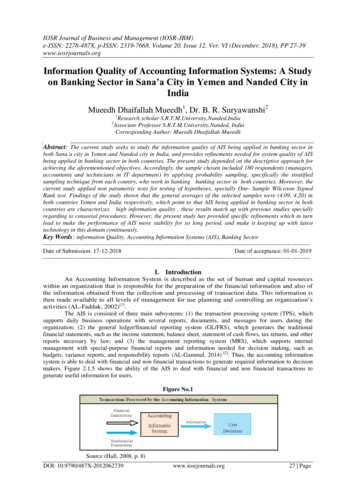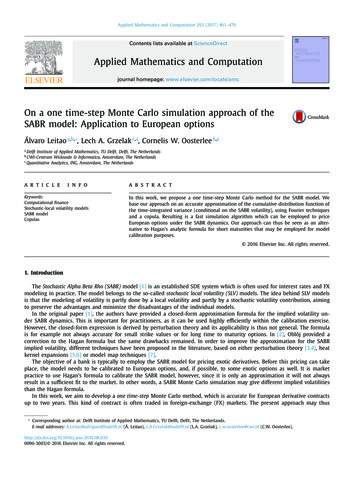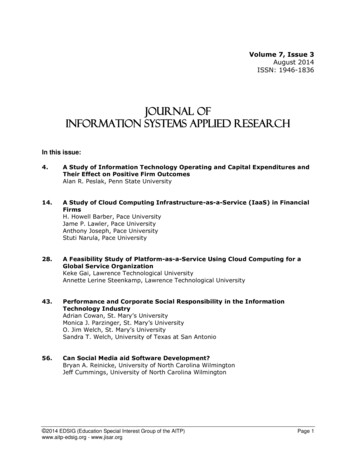
Transcription
Volume 7, Issue 3August 2014ISSN: 1946-1836Journal ofInformation Systems Applied ResearchIn this issue:4.A Study of Information Technology Operating and Capital Expenditures andTheir Effect on Positive Firm OutcomesAlan R. Peslak, Penn State University14.A Study of Cloud Computing Infrastructure-as-a-Service (IaaS) in FinancialFirmsH. Howell Barber, Pace UniversityJame P. Lawler, Pace UniversityAnthony Joseph, Pace UniversityStuti Narula, Pace University28.A Feasibility Study of Platform-as-a-Service Using Cloud Computing for aGlobal Service OrganizationKeke Gai, Lawrence Technological UniversityAnnette Lerine Steenkamp, Lawrence Technological University43.Performance and Corporate Social Responsibility in the InformationTechnology IndustryAdrian Cowan, St. Mary’s UniversityMonica J. Parzinger, St. Mary’s UniversityO. Jim Welch, St. Mary’s UniversitySandra T. Welch, University of Texas at San Antonio56.Can Social Media aid Software Development?Bryan A. Reinicke, University of North Carolina WilmingtonJeff Cummings, University of North Carolina Wilmington 2014 EDSIG (Education Special Interest Group of the AITP)www.aitp-edsig.org - www.jisar.orgPage 1
Journal of Information Systems Applied Research (JISAR)ISSN: 1946-18367(3)August 2014The Journal of Information Systems Applied Research (JISAR) is a double-blind peerreviewed academic journal published by EDSIG, the Education Special Interest Group of AITP,the Association of Information Technology Professionals (Chicago, Illinois). Publishingfrequency is currently quarterly. The first date of publication is December 1, 2008.JISAR is published online (http://jisar.org) in connection with CONISAR, the Conference onInformation Systems Applied Research, which is also double-blind peer reviewed. Our sisterpublication, the Proceedings of CONISAR, features all papers, panels, workshops, andpresentations from the conference. (http://conisar.org)The journal acceptance review process involves a minimum of three double-blind peer reviews,where both the reviewer is not aware of the identities of the authors and the authors are notaware of the identities of the reviewers. The initial reviews happen before the conference. Atthat point papers are divided into award papers (top 15%), other journal papers (top 30%),unsettled papers, and non-journal papers. The unsettled papers are subjected to a secondround of blind peer review to establish whether they will be accepted to the journal or not. Thosepapers that are deemed of sufficient quality are accepted for publication in the JISAR journal.Currently the target acceptance rate for the journal is about 40%.Questions should be addressed to the editor at editor@jisar.org or the publisher atpublisher@jisar.org.2014 AITP Education Special Interest Group (EDSIG) Board of DirectorsWendy CeccucciQuinnipiac UniversityPresident – 2013-2014Scott HunsingerAppalachian State UnivVice PresidentAlan PeslakPenn State UniversityPresident 2011-2012Jeffry BabbWest Texas A&MMembership DirectorMichael SmithGeorgia Institute of TechnologySecretaryGeorge NezlekUniv of North CarolinaWilmington -TreasurerEric BremierSiena CollegeDirectorNita BrooksMiddle Tennessee State UnivDirectorMuhammed MiahSouthern Univ New OrleansDirectorLeslie J. Waguespack JrBentley UniversityDirectorPeter WuRobert Morris UniversityDirectorS. E. KruckJames Madison UniversityJISE EditorNita AdamsState of Illinois (retired)FITE LiaisonCopyright 2014 by the Education Special Interest Group (EDSIG) of the Association of Information TechnologyProfessionals (AITP). Permission to make digital or hard copies of all or part of this journal for personal or classroomuse is granted without fee provided that the copies are not made or distributed for profit or commercial use. All copiesmust bear this notice and full citation. Permission from the Editor is required to post to servers, redistribute to lists, orutilize in a for-profit or commercial use. Permission requests should be sent to Scott Hunsinger, Editor,editor@jisar.org. 2014 EDSIG (Education Special Interest Group of the AITP)www.aitp-edsig.org - www.jisar.orgPage 2
Journal of Information Systems Applied Research (JISAR)ISSN: 1946-18367(3)August 2014Journal ofInformation Systems Applied ResearchEditorsScott HunsingerSenior EditorAppalachian State UniversityThomas JanickiPublisherUniversity of North Carolina WilmingtonJISAR Editorial BoardJeffry BabbGeorge NezlekWest Texas A&M UniversityUniversity of North Carolina WilmingtonWendy CeccucciAlan PeslakQuinnipiac UniversityPenn State UniversityGerald DeHondt IIDoncho PetkovJanet HelwigEastern Connecticut State UniversityDominican UniversityLi-Jen ShannonJames LawlerPace UniversityMuhammed MiahSam Houston State UniversityKarthikeyan UmapathyUniversity of North FloridaSouthern University at New Orleans 2014 EDSIG (Education Special Interest Group of the AITP)www.aitp-edsig.org - www.jisar.orgPage 3
Journal of Information Systems Applied Research (JISAR)ISSN: 1946-18367(3)August 2014A Feasibility Study of Platform-as-a-Service UsingCloud Computing for a Global Service OrganizationKeke Gaikgai@ltu.eduAnnette Lerine Steenkampsteenkamp@ltu.eduCollege of ManagementLawrence Technological UniversitySouthfield, Michigan 48075-1058, United States of AmericaAbstractThis paper reports on an investigation of information technology (IT) enablement for a global serviceorganization (small/medium enterprise [SME]), with focus on the feasibility of Platform-as-a-Service(PAAS) using cloud computing technology. A positivist-empirical research approach was followed toperform the feasibility analysis while also leveraging the benefits of cloud computing for an enterpriseportal in a way that adds value for the enterprise. The following tasks were performed: (1) problemanalysis of services, (2) literature review, (3) conceptualization of problem, (4) initiation and scopedefinition, (5) feasibility study, and (6) conceptualization of proposed solution. There were two maindeliverables, namely the feasibility report and a proposed implementation. The feasibility reportprovides analyses that align the IT strategy and enterprise strategy; a tactical and strategic analysis;a business process analysis; a defined value proposition; a cost benefit analysis; and a processperformance analysis. Based on the feasibility report an acquisition proposal for a cloud-based portalwith a PAAS implementation is formulated. The paper provides cloud practitioners with somerecommendations and practical references relating to implications for practices and procedures in theservices agency domain, security requirements, training requirements, and phased processimprovement. The findings of this investigation contribute to the body of knowledge for bothacademics and professionals regarding e-business. The investigation was conducted as part of anacademic course in collaboration with a real-world small to medium size agency with limitedresources. There are two limitations to this investigation: first, the proposed solution is conceptualand will be implemented in the next phase of the research project, and second, generalization of theproposed solution has potential and the solution could be examined for other service domains.Keywords: cloud computing,performance matrix.Platform-as-a-Service,1. formation technology (IT) enablement hasbecome an important approach and potentialsolution in many organizations (Davenport,businessprocessimprovement,process1993; Shtub & Karni, 2010). Also, the number oftheorganizationsutilizingadvancedITapproaches has been increasing in differentindustry fields due to the rapid development ofthe Internet-based technologies (Dutta & Mia,2010; Oliner & Sichel, 2000). Cloud computing, 2014 EDSIG (Education Special Interest Group of the AITP)www.aitp-edsig.org - www.jisar.orgPage 28
Journal of Information Systems Applied Research (JISAR)ISSN: 1946-1836as a new computing model running on theInternet, provides many organizations with anumber of new IT-based solutions and benefits,such as moderate cost, agility, and highefficiency (Gai & Li, 2012; Thomas, 2009). It isevident that leveraging cloud computing toimprove business processes is a hot topic inmany industries.This paper reports on an investigation on ITenablement that would improve businessprocesses and add value for a global serviceagency (GESA), a small/medium enterprise(SME), which provides study abroad services toglobal customers. The purpose of the projectwas to examine the feasibility of improving thebusiness processes and adding value for theagency by implementing a cloud-based portalwith Platform-as-a-Service (PAAS).The main problems of the enterprise wereidentified,andtworesearchquestionsformulated, as follows:1. What is the feasibility of creating new webbased services for a global service enterprisethat would add value through a cloud-basedapproach?2. What business processes of a global serviceenterprise are impacted when adopting cloudcomputing?The main outcome of the investigation is abusiness and technical feasibility report,consisting of a variety of analyses and plans,such as a business process analysis, ment plan, identified principles, drivenforces analysis, critical successful factors,project management plan, risk managementplan, business process performance analysis,and strategic plan. This paper is structured ings,limitations,andconclusions.2. PROBLEM ANALYSISIn recent years IT has become an importantoption for enterprises to add value to theirproducts or services (Maizlish & Handler, 2010;Alavi, Yoo & Vogel, 1997). In many situations ITsystems can help enterprises to reduce costs,increase efficiency, or improve/create services.With the advent of globalization the advantagesof IT have become significant by connectingcustomers and corporations more efficiently. The7(3)August 2014capabilities of IT systems also bring someopportunities for companies to add value,improve their business processes, and enable alean transformation by means of a range of ITbased solutions (Ilebrand, Mesoy & Vlemmix,2010). In this context problem analysis is afundamental process of understanding thenature of value creation by means of ITapproaches.GESA facilitates study abroad offerings formainly Chinese students. The vision of theagency is to promote global awareness andexchange of knowledge through cross-culturaleducation. The mission is to provide individualsor organizations with educational opportunitiesbetween China and the United States thatenhance international understanding betweenthe two countries, and a lifelong learningmindset.In order to achieve these strategic aims theagency has been operating a website thatprovidesbasicinformationabouttheorganization and its services. Nevertheless, thelimited scope of the website cannot effectivelysupport the business processes, and it becameclear that two main problems should be resolvedas a priority. The first is that the functionality ofthe website is not sufficient to add value to theservices and build a bridge between customersand the agency. Most business activities cannotbe completed on the website and customers donot have access to acquire a service or send aservice request via the interface provided by thewebsite. This lack of access to services results ina low-level interaction between the agency andits customers, and is also not positive for serviceimprovement.Secondly, the agency operates its business in aglobal context so that a fully functional websiteis really important for the company to expand itsmarket and communicate with its potentialcustomers, as has also been found by others(Liu, Arnett, Capella & Beatty, 1997; Turban,Leidner, McLean & Wetherbe, 2008). The currentstatus of the website may not be able toenhance the fine reputation of the company inthe target market and build a good customerrelationship (Liang & Chen, 2009). Improvementof business processes via a new IT enablementis a necessity for this organization.The objectives of service improvement weredistilled to the following: (1) improving businessprocesses through a cloud-based portal, (2) 2014 EDSIG (Education Special Interest Group of the AITP)www.aitp-edsig.org - www.jisar.orgPage 29
Journal of Information Systems Applied Research (JISAR)ISSN: 1946-1836adding value to the existing services andcreating new services, (3) reducing costs, and(4) increasing efficiency by leveraging state-ofart IT functionalities.7(3)August 2014(low cost), differentiation (through high quality),and niche specialization (through targetingspecial customers) were considered (Gartner,1985; Porter, 1985).In order to attain these objectives, the proposedservice improvement focused on a competitivestrategy, key value chains, representativebusiness processes in the services industry,approaches to process improvement, and cloudcomputing. The analysis of business s, namely strategic perspective,business process perspective, and technologicalperspective.Strategic PerspectiveThe strategic perspective mainly addressesissues that contribute to business processimprovement related to strategy. The analysis ofthe strategic perspective considered the valuechains, aspects of a competitive strategy andthe development of a strategy map.A value chain refers to a chain of processes andactivities that fully represent all behaviors oractions in an entire business process, whichusuallyincludesdesigning,producing,marketing, delivering, and other supportingactivities (Porter, 1980). Each activity is alignedwith a transition process, from resourceextraction to service delivery, which implies astep of adding value (Cohen, 2010). The primaryand support activities in the generic value chainmodel of Porter (1980) were interpreted forGESA: the primary activities (including services,finance, mar
(SME), which provides study abroad services to global customers. The purpose of the project was to examine the feasibility of improving the business processes and adding value for the agency by implementing a cloud-based portal with Platform-as-a-Service (PAAS). The
